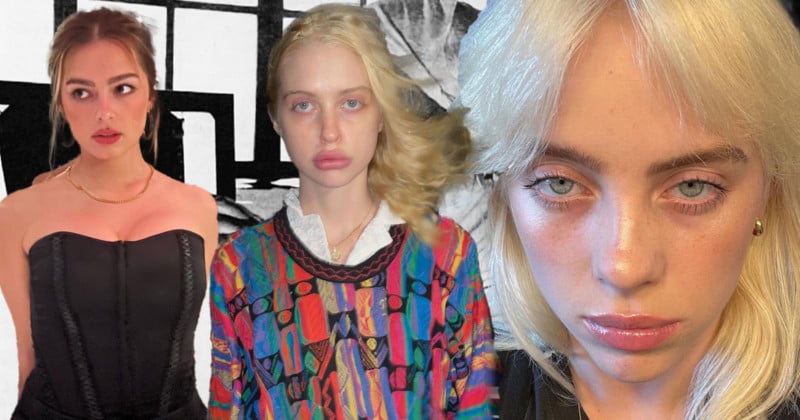The ‘Lobotomy-Chic’ Aesthetic is Taking Over Instagram

In a year that has seen the rise of blurry photos and 0.5 selfies, there has also been a new pose taking over Instagram in 2022. Featuring a blank stare and lifeless rolled eyes: meet the lobotomy-chic aesthetic.
For over a decade, Instagram users posed with the signature “duck face” expression favored by the picture-perfect Kardashians, sucking in their cheeks and pursing their lips to create a playful pout.
However, according to a piece published by Rayne Fisher-Quann in i-D, the duck face pose has been dethroned in 2022.
In the last year, social media has instead been dominated by models adopting a lobotomy chic aesthetic, also known as the “dissociative pout.”
The dissociative pout has become the go-to-pose on Instagram and sees subjects “favoring pouty, puffed-out lips stretched into a disaffected frown” with “wide eyes… either captured mid-roll or aimed at the camera in a plaintive, lobotomy-chic stare.”
Fisher-Quann says the goal of the dissociative pout is “the performance of detachment” and to look as uninterested, apathetic, and numb as possible.
The lobotomy chic aesthetic has been popularized by celebrities like Billie Eilish, Amelia Gray Hamlin Bella Hadid, TikTok star Addison Rae, and Euphoria actress Chloe Cherry whose photos have made her the poster-girl of the trend.
All of these Generation Z icons have posted casual selfies which show them posing with relaxed pouty lips, glazed-over eyes, and assuming the blankest expression they can muster to create a lobotomy girl appearance.
It is not just a specific pose that is important to the trend, a distinct style of photography plays a major role in this aesthetic too.
According to Dazed, photographer Stolenbesos has particularly defined the lobotomy chic aesthetic.
Stolenbesos’ work features deadpan models shot with cool-toned flash photography and framed in a pastel-and-black color palette.
Her subjects often pose in obscure settings with random objects to increase the sense of dissociation. Sometimes Stolenbesos’ models, whose faces are washed out by the flash, look like they are not even aware that the photograph is being taken at all.
It is no secret that Generation Z is fascinated by the Y2K era, as witnessed by TikTok’s revival of the point-and-shoot digital cameras of the early 2000s. And the lobotomy chic trend is certainly heavily influenced by early 2000s grunge aesthetics.
However, the recent popularity of the lobotomy chic aesthetic can be primarily linked to the many trends that have seen Generation Z rejecting the highly-edited, flawless visuals that they grew up seeing from their millennial counterparts.
Generation Z’s dissociative pout could not be further from its precursor, the duck face.
While the duck face required influencers to tense and exaggerate certain facial muscles, the dissociative pout requires little effort.
While the duck face pose screamed look-at-me, the lobotomy chic aesthetic focuses on apathy and “not caring” as a means of being powerful and attractive.
The dissociative pout trend is part of Generation Z’s shift away from taking picture-perfect photos in favor of a more “casual Instagram” aesthetic.
Younger people are drawn towards taking more seemingly authentic, imperfect, and candid photos on Instagram — but that does not make these images any less curated than their millennial predecessors.
“As the ‘casual Instagram’ trend shows, honest performativity in any form has been discarded in favor of a heavily-constructed facade of authenticity,” Fisher-Quann writes in i-D.
“Ring-light selfies have been replaced by blurry photos which are nonetheless casually-yet-meticulously photo-dumped in artful configuration,” he continues.
“Effort is out, baby — now, everyone is trying very hard to seem like they’re not trying hard at all.”
The dissociative pout can also be seen as part of a wider trend of women taking ownership of their image. Rather than simply being sexualized for the camera, the lobotomy chic aesthetic makes its subjects appear as undefinable and vague as possible.
Dazed writes that for lobotomy chic’s foremost photographer Stolenbesos, “the popularity of her style signifies a shift in how girls are allowed to exist within the photography world. Instead of being bland and sexy, female models can be autonomous, portraying themselves as they wish to be seen.”
“I actually hate the idea that lobotomy-chic is nihilistic,” Stolenbesos tells Dazed. “Because I think my work is optimistic and hopeful!”